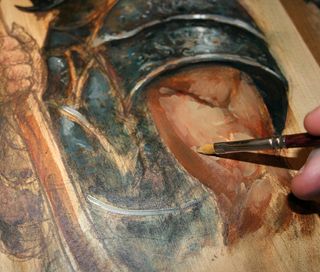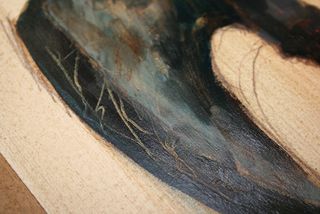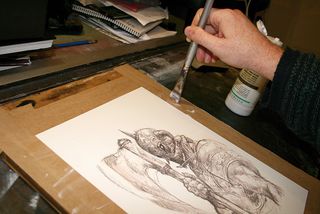You've learnt how to draw a range of subjects, assembled all the necessary tools, set up your own workspace and you're ready to start your artistic journey in paint. But before you do, it's worth knowing some fundamental painting techniques that will to help you along the way.
Here are seven essential painting techniques that will have you painting like a pro in no time.
01. Underpainting

Work paint up from thin to thick, especially when using slow-drying paints
I never work from white when using oils or acrylics. Create an underpainting in burnt umber or a mix of burnt sienna and phthalo blues to establish shadows and values. Acrylics are probably the best medium to use at this stage as they're quick-drying and permanent.
Work paint up from thin to thick, especially when using slow-drying paints. It's impossible to work on top of heavy, wet paint. In the same way, work up to highlights, adding the brightest (and usually heavier) paint at the end. Have a roll of kitchen towel to hand to clean brushes and remove any excess paint if you make a mistake.
02. Blocking in

Brushes come in a number of shapes and fibre types
Brushes come in a number of shapes and with different fibre types, all of which give very different results. The key is to try all of them as you paint. The most versatile are a synthetic/sable mix – these brushes can be used with most of the different paint types. Brushes come in flat and round types and it pays to have a selection of both. Check out our guide to picking the right brush to learn more.
I work with a range of brushes. For most of the early work I use larger, flatter and broader brushes. A filbert is a good general brush for blocking in form and paint. It has a dual nature, combining aspects of flat and round brushes so it can cover detail as well as larger areas. I tend to use smaller brushes only at the end of the painting process.
03. Building up texture

Have a dry flat brush you can use to blend and create smooth transitions
Have a dry, flat brush that you can use to blend your paint and create smooth transitions. I tend to like lots of texture and like to see brush marks in my own work. Almost anything can be used to add texture to your paint. There are ready-made texture media available, but I have seen items such as egg shell and sand used to add interest to a painting.
One tip is to use an old toothbrush to spatter your image with paint. This can be remarkably effective at suggesting noise and grain.
04. Dry brushing
This is a method of applying colour that only partially covers a previously dried layer of paint. Add very little paint to your brush and apply it with very quick, directional strokes.
This method tends to work best when applying light paint over dark areas/dried paint and is useful for depicting rock and grass textures.
05. Sgraffito

Removing paint can be as important as applying it
Removing paint can be as important as applying it. Sgraffito is the term used when you scratch away paint while it's wet to expose the underpainting. It's especially useful when depicting scratches, hair, grasses and the like.
You can use almost any pointed object for this – try rubber shaping tools or the end of a brush.
06. Glazing
Glazing is the process of laying a coat of transparent paint over a dry part of the painting, and it's used for intensifying shadows and modulating colour. A light transparent blue over dry yellow will of course create green.
07. Painting with mediums

Mediums can be added to paint to modulate its consistency, drying time and texture
Mediums are fluids that can be added to paint to modulate its consistency, drying time and texture. In the case of acrylics, you get different mediums that make the paint matte or gloss. However, I tend to use the matte medium mainly to seal my paper or board, so paint doesn't soak into it.




